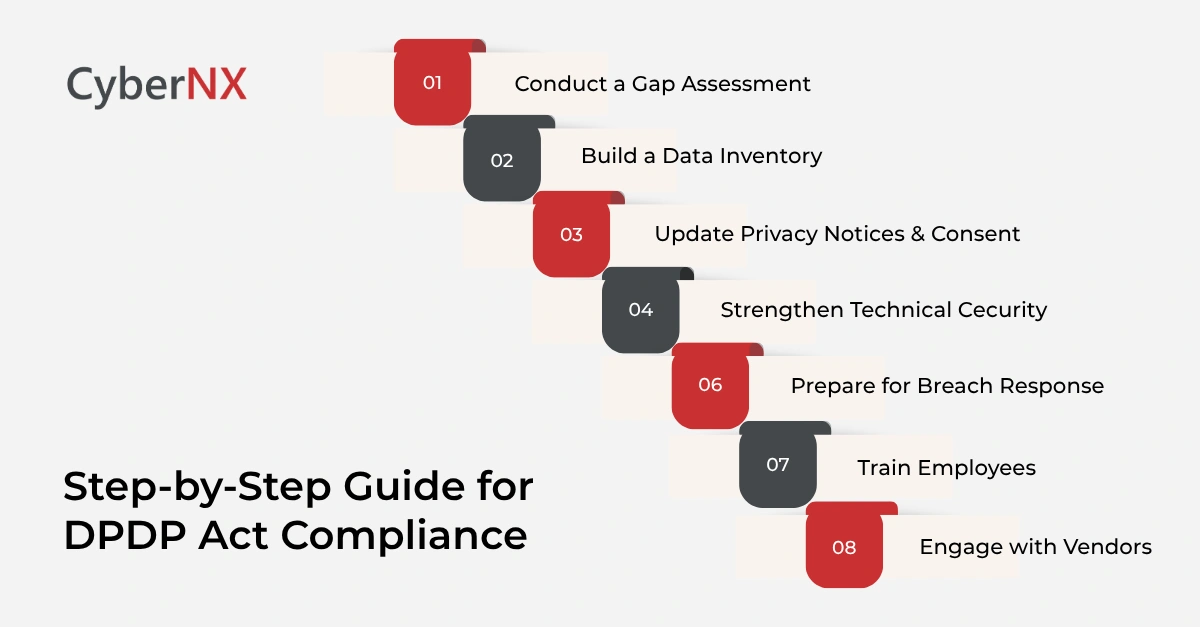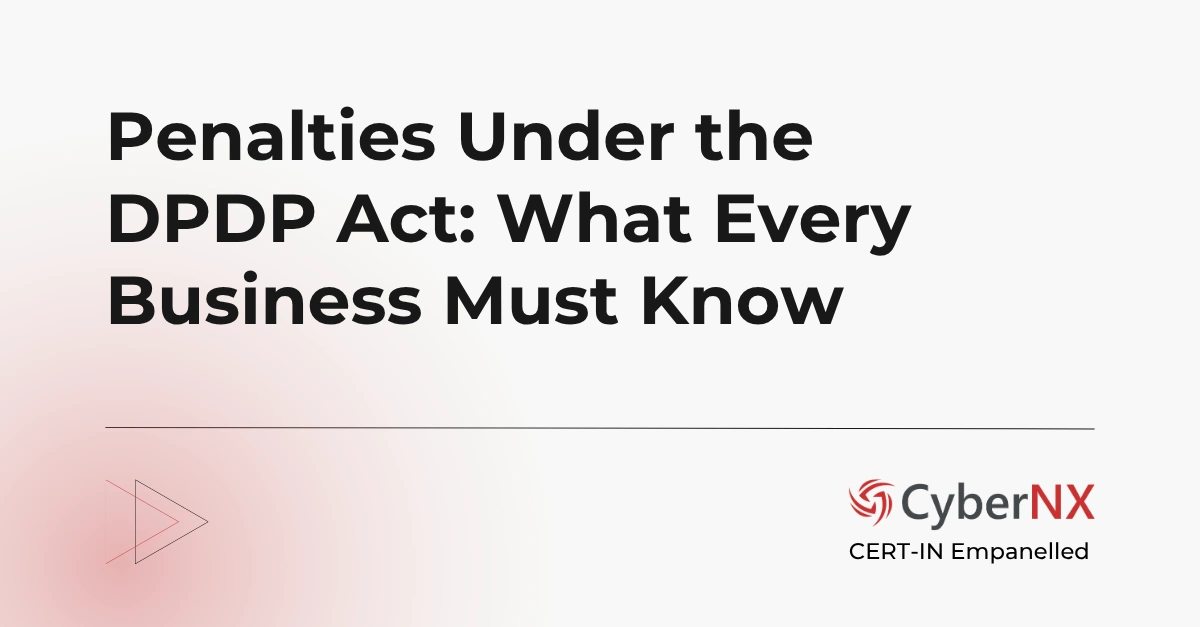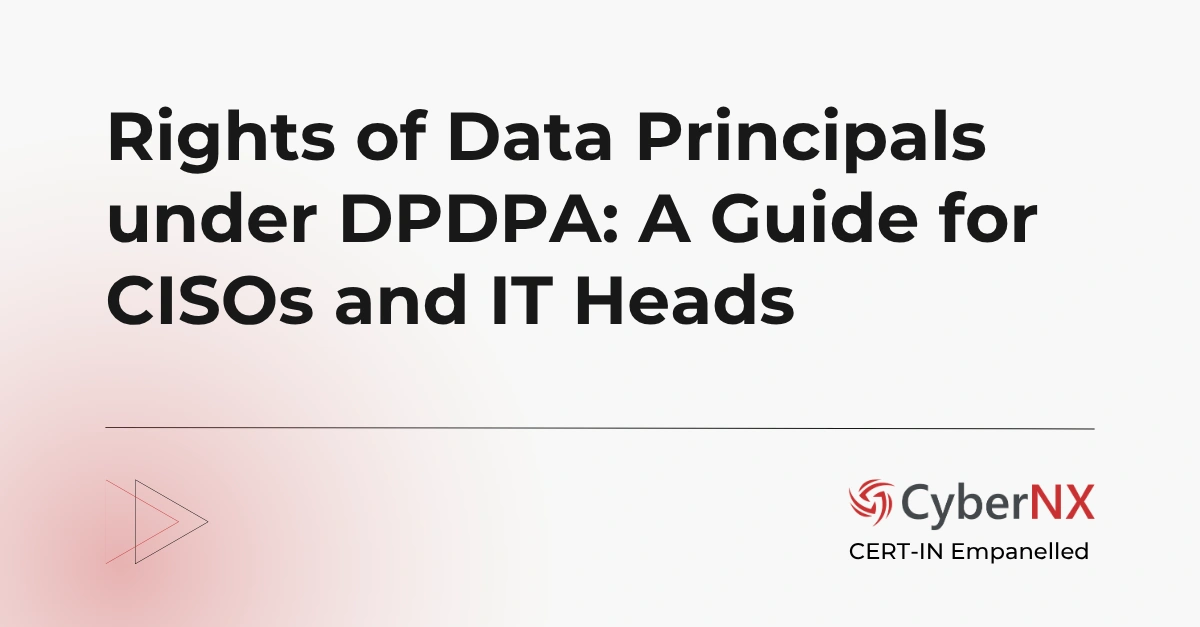India’s Digital Personal Data Protection Act (DPDP Act), 2023 is transforming how organisations collect, use, and safeguard personal data. It marks a new era where privacy, security, and governance work together to build stronger data management practices.
For security and compliance leaders, understanding DPDP Act compliance is crucial. It helps build customer trust, reduce regulatory exposure, and improve operational discipline.
In this guide, we explore what DPDP Act compliance means, outline the key obligations for data fiduciaries, and share practical steps to align your organisation with the law.
What is the DPDP Act?
The Digital Personal Data Protection Act, 2023 governs the processing of personal data in digital form. It aims to protect individuals’ rights while enabling responsible
data-driven innovation.
The law applies to:
- All entities operating within India.
- Foreign organisations offering goods or services to individuals in India.
It introduces key definitions that form the foundation of compliance:
- Data Principal: The individual whose personal data is processed.
- Data Fiduciary: The organisation determining the purpose and means of processing.
- Data Processor: The entity processing data on behalf of a fiduciary.
The Act also establishes the Data Protection Board of India (DPBI) to oversee compliance, manage grievances, and impose penalties for violations.
Why DPDP Act compliance matters
Data protection is no longer optional in a digital economy. Breaches and unauthorised use can quickly undermine trust, disrupt operations, and invite regulatory scrutiny.
Complying with the DPDP Act ensures that your organisation:
- Processes data fairly, lawfully, and transparently.
- Strengthens its cybersecurity posture.
- Avoids heavy penalties, which can reach ₹ 250 crore for serious violations.
- Demonstrates accountability to customers, investors, and regulators.
How to achieve DPDP Act compliance: A step-by-step roadmap
Building compliance takes time and structure. Once you are thorough with key DPDPA principles and guidelines, the following steps will help you move from awareness to action.
Step 1: Conduct a gap assessment
Start by evaluating your current privacy and security posture. Review policies, consent mechanisms, and data-sharing practices. Identify where personal data resides across your environment, including on-premises and cloud systems.
Step 2: Build a data inventory
A centralised data inventory helps you understand what personal data you hold and why you process it. Track:
- The type of data collected.
- The purpose of collection.
- The third parties it is shared with.
- How long it is retained.
Maintaining a data inventory simplifies audits, risk assessments, and breach response.
Step 3: Update privacy notices and consent workflows
Ensure that all digital touchpoints, such as websites and mobile apps, provide clear, accessible consent requests. Include details on how data will be used, links to privacy notices, and a simple process for withdrawing consent or raising grievances.
Step 4: Strengthen technical security
Security is at the heart of compliance. Adopt a layered defence strategy with:
- Encryption and network segmentation.
- Role-based access controls.
- Endpoint and email protection.
- Continuous monitoring and detection systems.
Document these controls to demonstrate compliance with the “reasonable security safeguards” requirement.
Step 5: Prepare for breach response
Data breaches can happen despite strong defences. Develop an incident-response plan that outlines:
- How to detect, contain, and investigate breaches.
- Timelines for notifying the Data Protection Board and affected users.
- Communication templates and escalation procedures.
Step 6: Train employees
Employees play a vital role in protecting personal data. Conduct regular training to raise awareness about handling sensitive information, recognising phishing, and reporting security incidents.
Step 7: Engage with vendors
Third-party vendors often process data on your behalf. Review contracts to ensure they align with DPDP obligations. Include clauses for breach reporting, data handling, and termination procedures to maintain accountability.
Step 8: Monitor compliance continuously
Compliance is ongoing. Use dashboards, metrics, and periodic audits to measure progress. Track indicators such as consent-response times, rights requests, and incident statistics to stay on course.
Common challenges in DPDP Act compliance
Every organisation faces hurdles on the path to compliance. Awareness of these challenges helps you plan better.
- Fragmented data systems: Data stored across multiple platforms makes it difficult to maintain visibility.
- Limited consent tracking: Older tools may not capture or record granular consent data.
- Third-party risk: Vendors may not follow equivalent data-protection standards.
- Evolving regulation: The upcoming subordinate rules (expected in 2025) will refine operational procedures.
- Cultural adoption: Moving from compliance awareness to accountability requires leadership support and cross-functional ownership.
The cost of non-compliance
The DPDP Act prescribes significant penalties for failing to meet obligations.
- ₹ 250 crore – failure to maintain adequate security safeguards.
- ₹ 200 crore – failure to report breaches or mishandling children’s data.
- ₹ 150 crore – non-compliance by Significant Data Fiduciaries.
- ₹ 50 crore – other general violations.
Penalties under DPDP Act are calculated per incident, meaning multiple lapses can multiply financial exposure.
Beyond monetary penalties, the real impact often lies in loss of customer confidence, reputational harm, and prolonged investigations.
Building a culture of Digital Personal Data Protection
Achieving compliance is not just a checklist exercise. It is about creating a culture that values privacy and transparency.
To create this culture:
- Make data protection a shared responsibility across teams.
- Integrate privacy reviews early in project lifecycles.
- Recognise and reward compliance-focused actions.
- Link privacy metrics to business performance indicators.
When privacy becomes part of your company’s DNA, compliance follows naturally.
How CyberNX helps you achieve DPDP Act compliance
We help organisations navigate India’s Digital Personal Data Protection Act (DPDPA) requirements. We do this by ensuring compliance while optimising business operations and mitigating risks associated with personal data processing.
Our DPDPA framework includes:
- Comprehensive Coverage: Our consulting services address all aspects of DPDPA compliance, from data mapping to implementation of technical and organizational measures.
- Business-Centric Approach: We balance compliance requirements with business objectives, ensuring practical and sustainable implementation.
- Actionable Roadmap: We provide a clear, prioritized implementation plan tailored to your organization’s specific needs and risk profile.
- Ongoing Support: Our team remains available for guidance as regulations evolve, and your data processing activities change.
In addition, we work closely with your team to design a compliance roadmap that is practical, sustainable, and aligned with your business operations.
- DPDP readiness assessments: Evaluate data-protection maturity and identify gaps.
- Data discovery and classification: Locate and categorise personal data across environments.
- Policy design and consent management: Build compliant, user-friendly consent workflows.
- Security implementation: Deploy monitoring, control, and incident-response frameworks.
- Staff training: Build awareness and accountability throughout your workforce.
Why businesses choose us for DPDP Act compliance?
We have helped leading companies across India who are proactively preparing to meet DPDA Act compliance requirements. And why do they choose us? Find out the major reasons why:
1. DPDPA specialized expertise
Our team includes certified privacy professionals with specialized knowledge of India’s DPDPA and its implementation requirements, ensuring accurate and up-to-date guidance.
2. Industry specific approach
We develop tailored compliance strategies for different sectors including banking, finance, healthcare, e-commerce, and IT/ITES, addressing unique data processing challenges.
3. Regulatory insights
Our strong understanding of the Data Protection Board of India’s approach and regulatory expectations helps clients navigate compliance requirements effectively.
4. Integrated compliance framework
We create a harmonized approach that aligns DPDPA compliance with other regulatory requirements (GDPR, CCPA, etc.) for efficient and comprehensive data protection programs.
Conclusion
Complying with the DPDP Act is a strategic step toward responsible data management. The Act underscores India’s growing commitment to global privacy standards and sets clear expectations for businesses operating in the digital space.
By investing in privacy governance, consent transparency, and strong security practices, organisations can build lasting trust with customers and stakeholders.
Partner with us to evaluate your Digital Personal Data Protection readiness. With our DPDA Act Consulting services, you can build a compliance programme that strengthens trust and resilience across your organisation.
DPDP Act compliance FAQs
Does the DPDP Act apply to offline data?
No. It applies only to digital personal data or data collected offline that is later digitised.
What is a Significant Data Fiduciary?
It refers to entities handling large volumes or sensitive personal data, or whose processing could cause significant harm, as designated by the government.
Is consent the only legal basis for processing data?
Mostly yes. The Act primarily relies on consent, with limited exceptions such as legal obligations or emergencies.
How can small businesses ensure compliance cost-effectively?
Focus on foundational measures such as transparent consent, clear privacy notices, and essential security controls. Affordable automation tools can simplify these processes.






